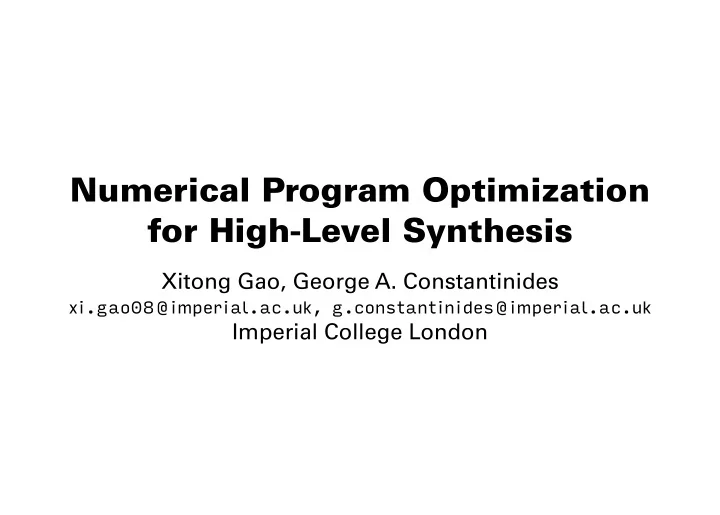

Numerical Program Optimization for High-Level Synthesis Xitong Gao, George A. Constantinides xi.gao08@imperial.ac.uk, g.constantinides@imperial.ac.uk Imperial College London
Introduction Floating-point operations... • are easy to use High dynamic range • are ubiquitous Altera introduced new FPGAs (Arria 10 and Stratix 10) with hardened floating-point DSP elements
Introduction Floating-point operations... • are easy to use High dynamic range • are ubiquitous Altera introduced new FPGAs (Arria 10 and Stratix 10) with hardened floating-point DSP elements However, floating-point operations • use a lot of resources • have round-off errors
Introduction Our tool exploits the rules of equivalence to automatically optimize the structure of numerical programs, for example: • (a + b) + c ≣ a + (b + c) • (a + b) * c ≣ a * b + a * c • and many more Error LUTs
Introduction • Simple transformations GCC / LLVM / Vivado HLS • What about accuracy? -ffast-math
Introduction • Simple transformations GCC / LLVM / Vivado HLS • What about accuracy? -ffast-math • Deep transformations SOAP Arithmetic • Resource usage & Expressions Accuracy!
Introduction • Simple transformations GCC / LLVM / Vivado HLS • What about accuracy? -ffast-math • Deep transformations SOAP Arithmetic • Resource usage & Expressions Accuracy! SOAP2 • Full program Full transformations Programs
Example Program if (x < 20) { x = x + (y + 500) ; } else { x = (x + y) + 500; }
Example Specification float x, y; assume(0 <= x <= 500); assume(err(x) == 0); assume(0 <= y <= 30); assume(err(y) == 0); Program if (x < 20) { x = x + (y + 500) ; } else { x = (x + y) + 500; }
Example Specification float x, y; assume(0 <= x <= 500); assume(err(x) == 0); assume(0 <= y <= 30); assume(err(y) == 0); Program if (x < 20) { x = x + (y + 500) ; } else { x = (x + y) + 500; }
Example Specification float x, y; assume(0 <= x <= 500); assume(err(x) == 0); assume(0 <= y <= 30); assume(err(y) == 0); Program if (x < 20) { x = x + (y + 500) ; } else { x = (x + y) + 500; }
Example Specification float x, y; assume(0 <= x <= 500); assume(err(x) == 0); assume(0 <= y <= 30); assume(err(y) == 0); Program if (x < 20) { x = x + (y + 500) ; } else { x = (x + y) + 500; }
Example Specification float x, y; assume(0 <= x <= 500); assume(err(x) == 0); assume(0 <= y <= 30); assume(err(y) == 0); Transform Program if (x < 20) { x = x + (y + 500) ; } else { x = (x + y) + 500; }
Example Specification Error float x, y; assume(0 <= x <= 500); assume(err(x) == 0); assume(0 <= y <= 30); assume(err(y) == 0); LUTs Transform • Pareto optimal • Pareto suboptimal Program if (x < 20) { x = x + (y + 500) ; } else { x = (x + y) + 500; }
Example Specification Error float x, y; assume(0 <= x <= 500); assume(err(x) == 0); assume(0 <= y <= 30); assume(err(y) == 0); LUTs • Pareto optimal • Pareto suboptimal Program if (x < 20) { x = x + (y + 500) ; } else { x = (x + y) + 500; }
Example Specification Error float x, y; assume(0 <= x <= 500); assume(err(x) == 0); assume(0 <= y <= 30); assume(err(y) == 0); LUTs • Pareto optimal • Pareto suboptimal Most accurate Program if (x < 20) { if (x < 20) { x = (x + y) + 500; x = x + (y + 500) ; } else { } else { x = x + (y + 500); x = (x + y) + 500; } }
Example Specification Fewest resources but less Error float x, y; accurate assume(0 <= x <= 500); assume(err(x) == 0); x = x + (y + 500); assume(0 <= y <= 30); assume(err(y) == 0); LUTs • Pareto optimal • Pareto suboptimal Most accurate Program if (x < 20) { if (x < 20) { x = (x + y) + 500; x = x + (y + 500) ; } else { } else { x = x + (y + 500); x = (x + y) + 500; } }
Example Specification Fewest resources but Error float x, y; less accurate assume(0 <= x <= 500); assume(err(x) == 0); x = x + (y + 500); assume(0 <= y <= 30); assume(err(y) == 0); Fewest resources but more accurate LUTs x = (x + y) + 500; • Pareto optimal • Pareto suboptimal Most accurate Program if (x < 20) { if (x < 20) { x = (x + y) + 500; x = x + (y + 500) ; } else { } else { x = x + (y + 500); x = (x + y) + 500; } }
And there is more... There are a lot of things we did not cover: • how we do that a more complex example program • work flow how it fits in the traditional HLS work flow • results ~60% better accuracy All of these above are in the poster!
Thank you! Join us in the poster session
Recommend
More recommend